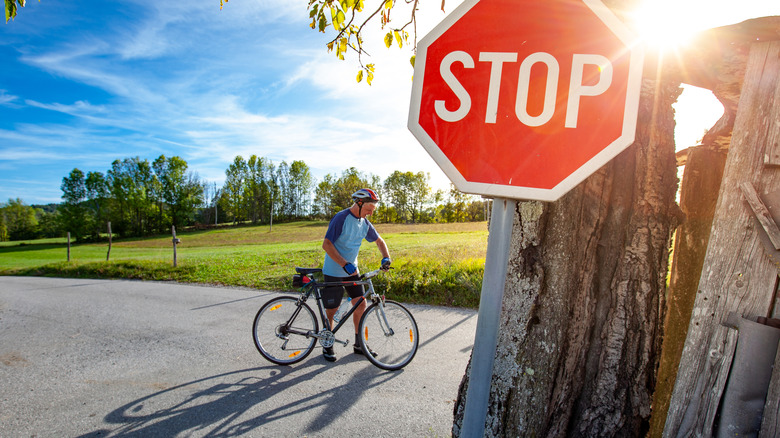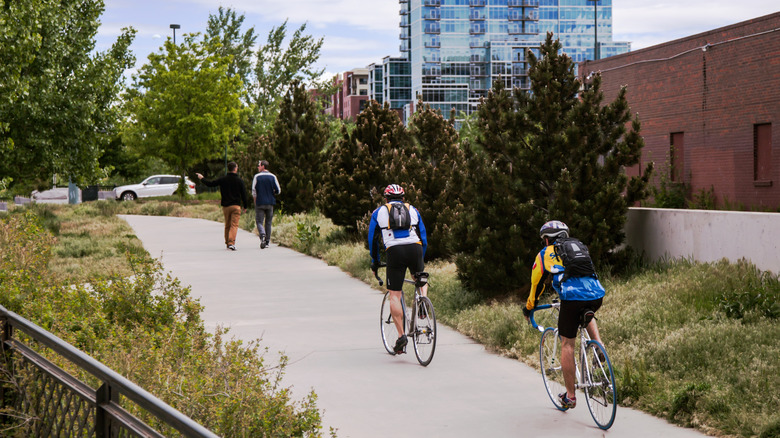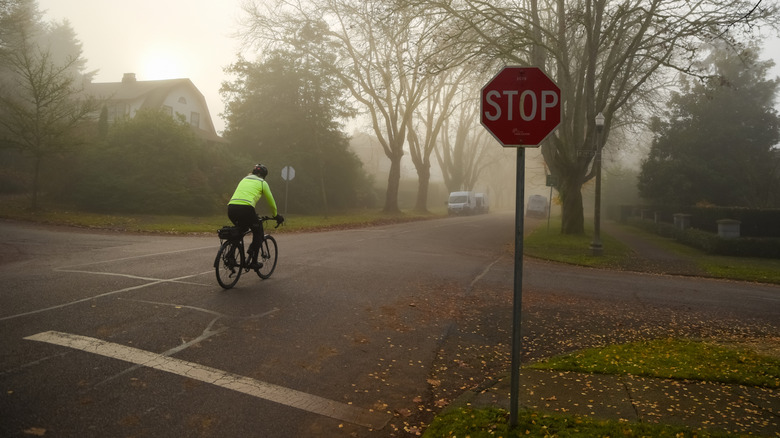Do Bicycles Have To Stop At Stop Signs In Colorado?
Colorado is known as a haven for outdoorsy types, and its cycling scene is no exception. From the city streets of Denver to the high altitude grades of Vail, almost three quarters of Coloradans own a bicycle, and a quarter ride for more than a month each year. But for drivers sharing the road with bicycles, riders can seem like obnoxious scofflaws. It's common to hear drivers complain that cyclists don't obey stop lights or stop signs. However, recent changes to Colorado law have legalized that behavior
As a driver pulling up to a stop sign in your pickup, you might feel a surge of anger as a road bike shoots past you and breezes through the intersection. The perception of cyclists as lawbreakers may be one reason why more than half of all drivers dehumanize cyclists, which can lead to road rage incidents. But as revealed in one study from the UC Berkeley School of Public Health, allowing cyclists to slow down at stop signs instead of halt is actually safer. After Idaho passed a law allowing cyclists to treat stop signs as yield signs and stop lights as stop signs, cyclist injuries decreased by 14.5 percent while bicycle safety rose to 30 percent higher than any comparable location.
Colorado's large cyclist population means that rider safety is a major concern. After looking at the data, the state legislature updated the rules of the road for cyclists at stop signs and traffic signals. Here's what you should know if you're cycling in the Centennial State.
Colorado cyclists can legally perform an Idaho stop
In 2022, Colorado governor Jared Polis signed the Idaho stop — also referred to as a safety stop — into state law, permitting cyclists to treat stop lights as stop signs and stop signs as yield signs. In practice, this means a cyclist must slow down as they approach a stop sign. If they have the right of way, they may proceed through at no more than 10 miles per hour. For instance, if a cyclist approaches a four way stop sign shortly before a driver, thus giving the cyclist the right of way, they may proceed through in front of the car without stopping first, whereas they would be required to yield to the driver if the driver approached the intersection first. At a stop light, the cyclist must come to a complete stop, yield to all other traffic and pedestrians, though they can proceed through once they deem it safe. However, left turns from a red light are only permitted with a one-way street.
The law is not limited to bicycles. It also applies to what the law calls "low-speed conveyances," which means electric scooters, e-bikes, skateboards, electric mobility aids, and so forth. However, it would not include vehicles like mopeds which are defined in other areas of Colorado law. Additionally, you must be 15 years of age or older to use the safety stop. Children under 15 may perform the safety stop while accompanied by a person of 15 or older who is also performing it.
Why the safety stop is safer for cyclists
It may seem counterintuitive that letting cyclists move through intersections without stopping would make roads safer for them and others. After all, intersections are dangerous, and the leading cause of fatal intersection accidents is a lack of traffic signals. But cyclists have different safety prioritiethan do drivers or pedestrians, as pointed out in that study from UC Berkeley.
There are a couple of reasons for this. First, getting a bike up to speed from a full stop requires a lot of energy, especially on a grade, and it's hard to control a bike without momentum. While getting up to speed from a complete stop, swerving to avoid an oncoming vehicle or other hazard becomes difficult or impossible, leading to accidents. Second, a cyclist is able to see and hear their surroundings more clearly than a driver, whose view and hearing are blocked by their own vehicle. Drivers often fail to see or hear cyclists, which means a cyclist must rely on their own experience and intuition. Ultimately, laws like Colorado's make the road safer for cyclists and more convenient for drivers, the definition of a win-win scenario.


